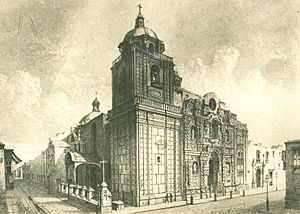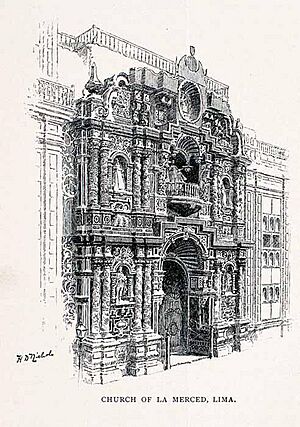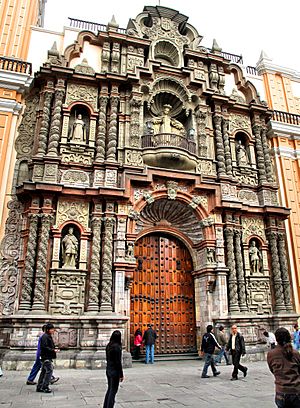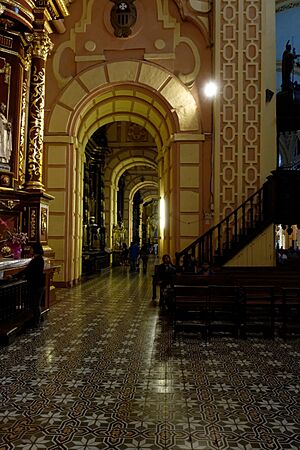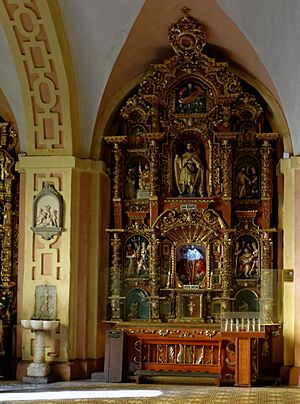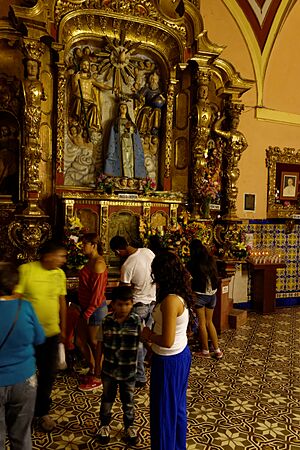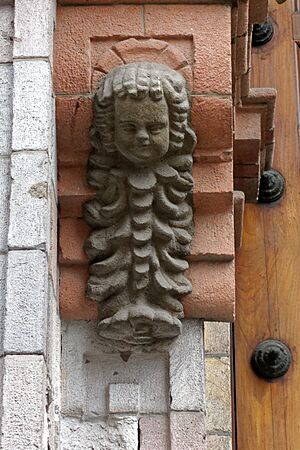Basilica and Convent of Nuestra Señora de la Merced facts for kids
Quick facts for kids Basilica y Convento de Nuestra Señora de la Merced |
|
|---|---|
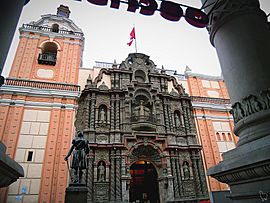
Façade
|
|
| Location | Lima |
| Country | Peru |
| Denomination | Roman Catholic |
| Membership | Order of the Blessed Virgin Mary of Mercy (Mercedarians) |
| History | |
| Founded | 1535 |
| Dedication | Virgin of Mercy |
| Architecture | |
| Style | Churrigueresque |
| Completed | 1765 |
The Basilica and Priory of Nuestra Señora de la Merced is a Roman Catholic church located in Lima, Peru. It's a very old and important church! It was built way back in 1535. The church is famous for its beautiful Baroque style, which is a fancy and detailed way of building. Inside, people honor the Blessed Virgin Mary of Mercy, who is also known as the patroness of the Peruvian Armed Forces. The Mercedarians, a religious group, helped build many churches in Lima, including this one, as they taught people about their faith.
Contents
Where is the Church?
The Basilica and Convent of Nuestra Señora de la Merced is in the heart of Lima, Peru. You can find it where two streets meet: Jirón de la Unión and Jirón Antonio Miró Quesada. It's right in the historic center of Lima, a very old part of the city.
A Look at History
The convent and church of Nuestra Señora de la Merced are as old as the city of Lima itself. Historical papers show that the land for the church belonged to the Mercedarian religious group. In 1534, a captain named Francisco de Becerra gave money to help build the first convent. He and his wife are buried in the church's crypt.
The Mercedarians came to Peru to teach the local people. The first church was made of wood. The building you see today is made of adobe and brick. The fancy Baroque entrance was carved in 1591 by Cristóbal Gómez.
In 1589, after an earthquake, a square tower was added to the church. This tower was one of the first tall buildings in colonial Lima. Later, in 1592, the architect Cristóbal Gómez rebuilt part of the convent.
The church had a chapel with many artworks. In 1603, a sculpture of the Virgin of Mercy was carved. There was also a large painting by Angelino Medoro from 1600.
In 1608, the main part of the church, called the nave, was updated and made bigger. This changed the church from having one main aisle to three open aisles. This new style was then copied in other churches in Lima and across South America.
Earthquakes and Rebuilding
An earthquake in 1609 slowed down the work on the church. Building started again in 1613. Another earthquake in 1687 damaged parts of the church and convent. Francisco Javier Domínguez led the rebuilding efforts. In 1696, the stone entrance we see today was built.
Between 1687 and 1746, more additions were made. In 1702, an altarpiece was finished. In 1714, paintings of the four evangelists were added to a chapel. In 1730, the Virgin of Mercy was declared the "Patroness of the Fields of Lima." In 1739, a statue called the Lord of Help was created.
The biggest earthquake in 1746 destroyed much of the church and convent. Rebuilding took many years, through the second half of the 1700s. A fire in 1775 also caused damage.
Important parts rebuilt after these events include:
- The tower, main staircase, and inside balconies (1759-1762).
- The entrance (1762-1765).
- The dome decorations and the sacristy (1765-1768).
- The library (1774).
- The second floor of the main cloister (1777-1780).
- New altars and paintings about the life of St. Peter Nolasco (1781-1792).
- New church bells were made and installed (1786-1798). These bells still ring for important ceremonies today.
In the early 1800s, Matías Maestro updated the altarpiece. In 1860, Guillermo D'Coudry directed more restoration work. In the early 1900s, the church's front was covered with plaster. This plaster was removed in 1940, bringing back the original look of the church.
The Altarpieces and the Virgin of Mercy
The church has many beautiful altarpieces, which are decorated screens behind the altar. The main altarpiece is covered in gold. In its center is a special image of the Virgin of Mercy. In 1615, she was called the "heavenly protector of Lima." In 1730, she became the "Perpetual Patroness of the Fields of Lima."
Later, in 1823, she was named patroness of the Arms of Peru. In 1921, she received the special title of Gran Mariscala, or "Great Marshal Woman." The Virgin holds chains and a scapular, which are symbols of her religious order. She also holds a gold scepter.
Another altar honors the Holy Christ of Help. This statue was made by Juan Martínez Montañés.
Inside the Convent
The front of the church shows the Liman Churrigueresque style. It has a statue of the Virgin of Mercy in the middle, surrounded by other figures.
The convent has three main courtyards, called cloisters. The main cloister is large and has altars with colorful azulejo tiles. The Cloister of Doctors is named for carvings that show Mercedarian members who were professors at the National University of San Marcos. A grand staircase under a dome connects the main cloister and the Cloister of Doctors.
The library holds old religious books. It also has the chair where Friar Pedro Urraca sat, which is now seen as a special relic. The sacristy, a room where priests prepare, has the historical Cross of the Conquest. This cross was brought by the Mercedarians.
Inside the Basilica, some niches hold statues of important indigenous figures like the Lord of Huanca and the Lord of Cachuy.
Friar Pedro Urraca
Pedro Urraca was born in Spain in 1583. When he was 19, he traveled to Peru. A story says that his ship almost sank in a big storm. Pedro Urraca prayed to the Virgin Mary, promising his life if everyone was safe. The storm calmed, and the ship reached Quito safely. There, he began his religious training.
He then moved to Peru. For many years, he wore chains on his body as a way to show his devotion. After thirty years, the chains had become part of his skin. Doctors had to remove them. He later returned to Spain and became a spiritual guide for Queen Elisabeth of France.
Even though he was asked to stay at the royal court, he returned to Lima. He passed away on August 7, 1657, at 74 years old. His remains are in the church floor. An inscription there says: "In this place and under the earth rests the body of the Servant of God Friar Pedro Urraca de the Holy Trinity." Efforts to declare him a saint began in 1682. In 1981, Pope John Paul II declared him "Venerable," which is a step towards sainthood.
See also
 In Spanish: Basílica y convento de Nuestra Señora de la Merced (Lima) para niños
In Spanish: Basílica y convento de Nuestra Señora de la Merced (Lima) para niños
- Plazoleta de la Merced


